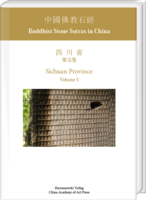|
weitere Titel zum Thema:
Download:
The fifth volume on the inscriptions carved in cave chapels at the Grove of the Reclining Buddha (Wofoyuan) in Anyue County, Sichuan, presents sections E and F on the southern escarpment of the Grove. In five of the sixteen caves, a total of eight walls are engraved with sutra texts. The Diamond Sutra and the Heart Sutra in cave 71 are followed by an undated but probably eighth century colophon and a dhāraṇī spell in large characters. Engraved in cave 73 are two colophons dated 727 and 733 and six chapters of the Synoptic Golden Light Sutra (Hebu Jinguangming jing). Its text continues in cave 76. These are the only caves in China where this sutra is found. In cave 83 an attempt was made to progress with the engraving of the Nirvāṇa Sutra. Cave 85 contains the entire Vimalakīrti Sutra in an unusual layout. The central chapter 12, in which the Buddha adresses Vimalakirti, is here seen on the rear wall, where ordinarily a statue of the Buddha would be placed. Three large line drawings in the caves can stylistically be dated to the 9th/10th century. A long inscription of 1103 in cave 81 talks about the disasters that had befallen the monastery, including a contagious disease.
All engravings are fully reproduced in detailed photographs of the cave walls. They are juxtaposed with photographs of ink rubbings or visualizations of 3D laser scans. The texts are transcribed with a scholarly apparatus noting textual variants and variant characters in the calligraphy. An essay by Lothar Ledderose presents the two sections and highlights their peculiarities and their significance. In his magisterial study on The *Suvarṇabhāsottama-sūtra Michael Radich presents a comprehensive analysis of the textual history of the Synoptic Golden Light Sutra, and elucidates the singularity of this particular version in the Grove. The texts are in Chinese and English throughout. |






